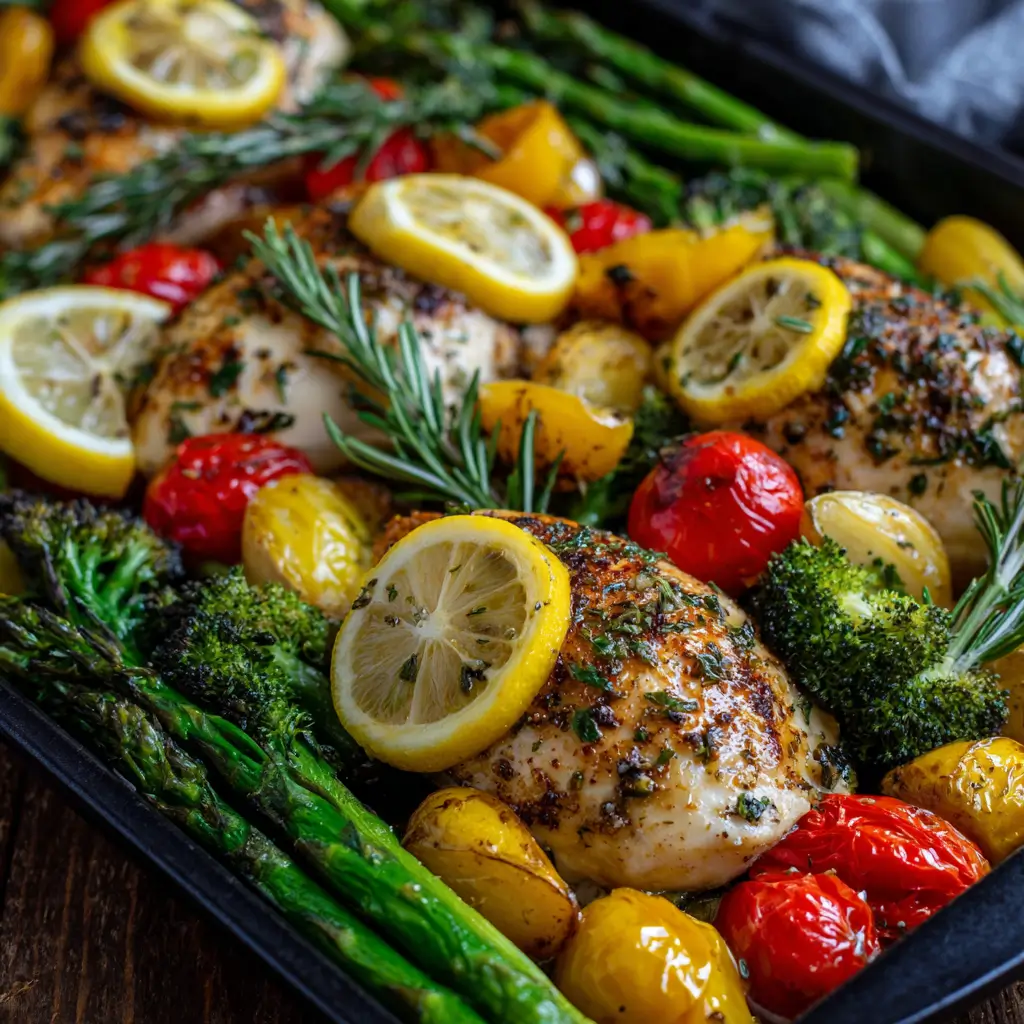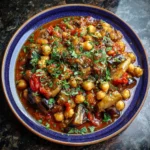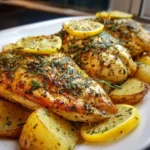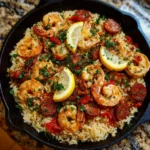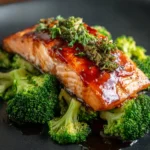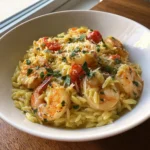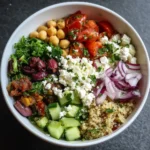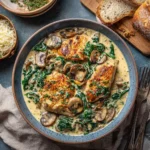Sheet Pan Lemon Herb Chicken and Veggies: A Complete Guide to the Perfect One-Pan Meal
The History of Sheet Pan Meals
The concept of sheet pan meals has its roots in practical, time-saving cooking traditions that date back decades. Originally popularized in commercial kitchens and bakeries—where large metal trays were used for roasting meats and vegetables efficiently—sheet pans eventually made their way into home cooking during the mid-20th century. As lifestyles became busier and people sought ways to minimize cleanup while maximizing flavor, the idea of combining protein and vegetables on a single pan gained traction.
By the 2010s, sheet pan dinners exploded in popularity thanks to food blogs, social media, and meal prep culture. The simplicity, efficiency, and delicious results made them a go-to option for families, working professionals, and health-conscious individuals alike. Among the most beloved variations is Sheet Pan Lemon Herb Chicken and Veggies, a dish that perfectly balances tangy citrus notes with aromatic herbs and tender roasted vegetables. Its Mediterranean-inspired flavor profile draws from culinary traditions across Southern Europe and the Middle East, where lemon and olive oil are staples of everyday cooking.
Ingredients Breakdown
To create a flavorful, nutritious, and visually appealing Sheet Pan Lemon Herb Chicken and Veggies, it’s important to understand the role each ingredient plays:
- Chicken Breasts or Thighs: Boneless, skin-on chicken thighs offer more moisture and richness due to higher fat content, while chicken breasts are leaner and cook faster. Both work well, but thighs tend to stay juicier during roasting.
- Fresh Lemons: Provides bright acidity and enhances browning through natural citric acid. Zest adds intense aroma; juice adds tanginess and helps form a glaze when combined with oil and herbs.
- Olive Oil: Extra virgin olive oil coats ingredients evenly, promotes caramelization, and carries flavors. It also helps crisp up edges of vegetables without drying out the chicken.
- Fresh Herbs: Rosemary, thyme, oregano, and parsley are classic choices. Rosemary brings pine-like depth, thyme offers earthiness, oregano adds a slightly peppery note, and parsley provides freshness at the end.
- Garlic: Minced fresh garlic infuses savory umami throughout the dish. Roasted garlic becomes sweet and mellow, enhancing overall complexity.
- Vegetables: A colorful mix ensures both visual appeal and nutritional diversity. Common options include:
- Potatoes (Yukon Gold, red, or fingerling): Hearty and starchy, they absorb flavors beautifully.
- Carrots: Sweetness intensifies when roasted, balancing the tart lemon.
- Zucchini and Yellow Squash: Tender with mild flavor, they roast quickly and add vibrant color.
- Red Bell Peppers: Juicy and slightly sweet, their high water content steams nearby ingredients slightly, aiding even cooking.
- Red Onion: Adds sharpness when raw but mellows into sweetness when roasted, contributing layers of flavor.
- Salt and Black Pepper: Essential seasonings that enhance all other flavors. Kosher salt is preferred for its clean taste and easy dispersion.
- Optional Additions: Capers for brininess, olives for Mediterranean flair, cherry tomatoes for bursts of sweetness, or feta cheese crumbles added after baking for creaminess.
Step-by-Step Recipe
Follow these detailed steps to achieve restaurant-quality results right in your own kitchen:
- Preheat Oven: Set oven to 400°F (200°C). This temperature allows vegetables to caramelize and chicken to cook through without drying out.
- Prepare Ingredients:
- Cut chicken into uniform pieces (1.5-inch cubes if desired, or leave whole breasts/thighs).
- Peel and chop potatoes into 1-inch chunks.
- Slice carrots diagonally into ½-inch thick pieces.
- Quarter red onions and cut bell peppers into 1-inch squares.
- Halve zucchini and yellow squash lengthwise, then slice crosswise into half-moons.
- Mince garlic, zest one lemon, and juice two lemons (about ⅓ cup total).
- Make Marinade/Sauce: In a large bowl, whisk together:
- ¼ cup extra virgin olive oil
- ⅓ cup fresh lemon juice
- 1 tablespoon lemon zest
- 4 cloves minced garlic
- 1 tablespoon chopped fresh rosemary (or 1 tsp dried)
- 1 tablespoon chopped fresh thyme (or 1 tsp dried)
- 1 teaspoon dried oregano
- 1½ teaspoons kosher salt
- ½ teaspoon freshly ground black pepper
- Marinate Chicken: Place chicken in a separate bowl or resealable bag and pour half the marinade over it. Toss to coat. Let sit for at least 15 minutes (or up to 2 hours in the fridge) for deeper flavor penetration.
- Toss Vegetables: In the large mixing bowl, combine all chopped vegetables. Pour the remaining half of the marinade over them and toss thoroughly until evenly coated.
- Arrange on Sheet Pan: Use a large rimmed baking sheet (preferably lined with parchment paper or lightly greased foil for easy cleanup). Spread vegetables in an even layer, ensuring space between pieces to allow proper roasting instead of steaming.
- Add Chicken: Place marinated chicken pieces on top of the vegetables, spacing them apart so they don’t overcrowd. If using whole breasts, lay them skin-side up for better browning.
- Raise Chicken Slightly (Optional Tip): For crispier skin, place chicken on a wire rack set over the sheet pan. This allows hot air to circulate underneath.
- Roast: Bake in preheated oven for 20 minutes. Then, use tongs to flip chicken and stir vegetables gently. Rotate the pan front-to-back for even cooking if your oven has hot spots.
- Continue Baking: Roast for another 15–25 minutes, depending on thickness of chicken. Internal temperature should reach 165°F (74°C) when checked with a meat thermometer inserted into the thickest part.
- Broil for Finish (Optional): Turn on broiler for 2–3 minutes to deepen browning and crisp edges. Watch closely to prevent burning.
- Rest and Garnish: Remove from oven and let rest for 5 minutes. Sprinkle with freshly chopped parsley and an extra squeeze of lemon juice before serving.
Pro Tips for Success
- Uniform Cutting: Cut all ingredients to similar sizes to ensure even cooking. Dense vegetables like potatoes and carrots take longer than zucchini or peppers.
- Don’t Overcrowd the Pan: Use two sheet pans if necessary. Overlapping causes steaming rather than roasting, leading to soggy textures.
- Dry Ingredients: Pat chicken dry with paper towels before seasoning to promote browning.
- Use High Heat: 400°F is ideal. Lower temps may result in mushy veggies; higher can burn exteriors before interiors cook.
- Flip Halfway: Stirring halfway ensures golden edges and prevents sticking.
- Lemon Timing: Avoid adding lemon slices too early—they can become bitter. Add thin lemon rounds during the last 10 minutes for presentation and subtle infusion.
- Check Doneness Early: Ovens vary. Start checking chicken temp around 30 minutes to avoid overcooking.
- Let It Rest: Allows juices to redistribute in chicken, keeping it moist.
Variations and Customizations
This recipe is highly adaptable based on dietary needs, seasonal availability, and personal taste:
- Low-Carb/Keto Version: Replace potatoes with cauliflower florets, radishes, or turnips. These mimic potato texture when roasted but are lower in carbs.
- Paleo/Whole30 Approved: Ensure no added sugars in spices and use compliant oils. Skip dairy-based garnishes like feta.
- Vegetarian Alternative: Swap chicken for chickpeas, tofu, tempeh, or halloumi cheese. Marinate similarly for cohesive flavor.
- Gluten-Free: Naturally gluten-free—just confirm spice blends are certified GF if needed.
- Spicy Kick: Add red pepper flakes, sliced jalapeños, or a drizzle of harissa paste to the marinade.
- Mediterranean Twist: Include Kalamata olives, artichoke hearts, sun-dried tomatoes, and finish with crumbled feta and fresh mint.
- Herb Variations: Try dill, tarragon, or basil for different aromatic profiles. Dill pairs especially well with lemon and fish, but works nicely here too.
- Root Vegetable Medley: Use parsnips, sweet potatoes, beets, or rutabaga in fall and winter months.
- Citrus Swaps: Substitute lemon with lime, orange, or grapefruit for unique flavor dimensions. Orange complements rosemary beautifully.
- Meal Prep Friendly: Double the batch and portion into containers for up to 4 days in the fridge. Reheat in oven or skillet for best texture.
Health Considerations and Nutritional Value
Sheet Pan Lemon Herb Chicken and Veggies isn’t just convenient—it’s a nutritionally balanced meal rich in essential vitamins, minerals, and healthy fats.
Nutrition Highlights (per serving, approx. 1/4 of recipe):
- Calories: ~400–480 kcal (varies by cuts and oil amount)
- Protein: 35–40g – supports muscle repair and satiety
- Fat: 18–22g – mostly unsaturated from olive oil, beneficial for heart health
- Carbohydrates: 25–30g – primarily complex carbs and fiber from vegetables
- Fiber: 5–7g – aids digestion and gut health
- Vitamin C: High from lemon juice and bell peppers—boosts immunity and collagen production
- Vitamin A: From carrots and peppers—supports vision and immune function
- Potassium: Found in potatoes, zucchini, and spinach (if added)—helps regulate blood pressure
- Antioxidants: Polyphenols in olive oil and various phytonutrients in colorful vegetables reduce inflammation
Benefits of Key Components:
- Lemon Juice: Aids iron absorption from plant foods, stimulates digestion, and may support liver detoxification pathways.
- Olive Oil: Linked to reduced risk of cardiovascular disease and improved cholesterol levels due to monounsaturated fats and antioxidants like oleocanthal.
- Garlic: Contains allicin, which has antimicrobial and anti-inflammatory properties.
- Herbs: Fresh herbs like rosemary and thyme contain rosmarinic acid and thymol—potent antioxidants with potential neuroprotective effects.
- Balanced Macros: Combines lean protein, complex carbs, and healthy fats—ideal for sustained energy and metabolic balance.
Dietary Notes:
- Suitable for low-sodium diets if salt is reduced or replaced with herbs and citrus.
- Diabetics can enjoy this dish as part of a balanced plan; pairing with non-starchy veggies helps manage glycemic load.
- Kidney-friendly if potassium-rich ingredients (like potatoes) are limited or soaked prior to cooking.
Full Ingredient List
Serves: 4 | Prep Time: 20 mins | Cook Time: 35–40 mins | Total Time: ~60 mins
- 1.5 lbs (680g) boneless, skin-on chicken thighs or breasts, cut into 1.5-inch pieces
- 1 lb (450g) Yukon gold potatoes, cut into 1-inch cubes
- 2 medium carrots, sliced diagonally
- 1 medium zucchini, halved and sliced
- 1 medium yellow squash, halved and sliced
- 1 red bell pepper, chopped
- 1 small red onion, quartered
- ¼ cup extra virgin olive oil
- ⅓ cup fresh lemon juice (from about 2 lemons)
- 1 tbsp lemon zest (from 1 lemon)
- 4 cloves garlic, minced
- 1 tbsp fresh rosemary, finely chopped (or 1 tsp dried)
- 1 tbsp fresh thyme leaves (or 1 tsp dried)
- 1 tsp dried oregano
- 1½ tsp kosher salt
- ½ tsp black pepper
- 2 tbsp fresh parsley, chopped (for garnish)
- Additional lemon wedges (for serving)
Detailed Directions
- Preheat & Prepare: Preheat oven to 400°F (200°C). Line a large rimmed baking sheet with parchment paper or aluminum foil for easier cleanup.
- Chop Vegetables: Wash and cut all vegetables as specified. Keep denser ones (potatoes, carrots) separate from quicker-cooking ones (zucchini, peppers).
- Marinate Chicken: In a bowl, combine half the lemon juice, 2 tablespoons olive oil, half the garlic, ½ tablespoon rosemary, ½ tablespoon thyme, ½ teaspoon salt, and ¼ teaspoon pepper. Add chicken, toss well, cover, and refrigerate for 15–60 minutes.
- Make Veggie Mixture: In a large bowl, mix potatoes, carrots, zucchini, squash, bell pepper, and red onion. Add remaining olive oil, lemon juice, garlic, herbs, salt, and pepper. Toss until fully coated.
- Layer on Pan: Spread vegetable mixture evenly on prepared sheet pan. Nestle marinated chicken pieces among the veggies, spacing them apart.
- Roast First Stage: Bake for 20 minutes. Remove from oven, flip chicken pieces, and stir vegetables gently to promote even browning.
- Second Roast: Return to oven and bake for another 18–22 minutes, or until chicken reaches 165°F internally and potatoes are fork-tender.
- Optional Broil: Switch oven to broil for 2–3 minutes to crisp tops and deepen color. Monitor closely.
- Final Touches: Remove from oven. Let stand 5 minutes. Sprinkle with fresh parsley and serve with extra lemon wedges.
- Serving Suggestions: Pair with quinoa, couscous, brown rice, or serve as-is for a low-carb option. Drizzle with balsamic glaze or tzatziki for added richness.
Frequently Asked Questions (FAQ)
Can I use frozen vegetables?
It’s not recommended. Frozen veggies release excess moisture when thawed and roasted, resulting in a soggy texture. Always use fresh for best results.
Can I make this ahead of time?
Yes! Chop vegetables and marinate chicken the night before. Store separately in airtight containers. Assemble and roast when ready.
How do I store leftovers?
Cool completely and store in an airtight container in the refrigerator for up to 4 days. Reheat in oven at 350°F for 10–15 minutes or microwave in short intervals.
Can I freeze this dish?
While possible, freezing may alter texture—especially in zucchini and potatoes, which can become watery upon thawing. Best enjoyed fresh or refrigerated.
Why is my chicken dry?
Overcooking is the main culprit. Use a meat thermometer and remove chicken once it hits 165°F. Also, consider using thighs instead of breasts for more forgiving moisture retention.
What kind of pan should I use?
A large, heavy-duty rimmed baking sheet (half-sheet pan, approx. 13×18 inches). Avoid dark nonstick pans if possible—they can cause over-browning. Light-colored aluminum pans provide more even heat distribution.
Can I add potatoes later?
If you want to prevent overcooking softer veggies, add potatoes first. Roast for 15 minutes, then add quicker-cooking vegetables and chicken. Adjust timing accordingly.
Is this recipe dairy-free?
Yes, as written, it contains no dairy. Just ensure any optional additions (like feta or butter) are omitted or substituted.
Can I use dried herbs instead of fresh?
Yes, but use one-third the amount (dried herbs are more concentrated). For example, 1 tablespoon fresh = 1 teaspoon dried.
How can I make it kid-friendly?
Reduce garlic and strong herbs slightly. Serve with a side of hummus or yogurt dip. You can also dice everything small and call it “chicken treasure bake”!
Summary
Sheet Pan Lemon Herb Chicken and Veggies is a wholesome, flavorful, and effortless one-pan meal that brings the bright tastes of the Mediterranean to your dinner table. Packed with lean protein, colorful produce, and heart-healthy fats, it’s as nutritious as it is delicious.
Perfect for weeknights, meal prep, or impressing guests, this dish proves that simple ingredients, smart technique, and a little citrus magic can create something truly extraordinary with minimal effort and cleanup.
